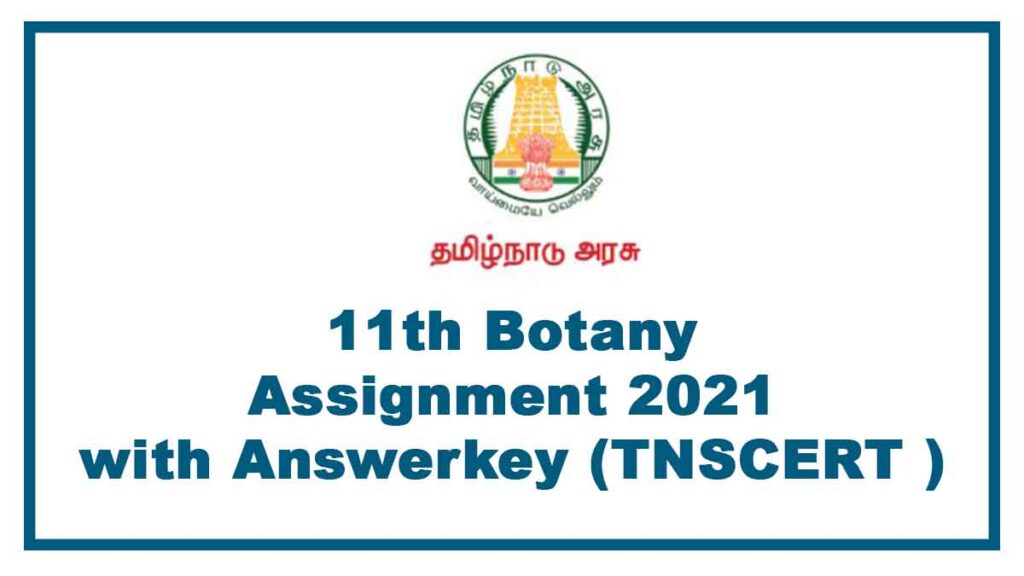11th Botany Assignment English Medium Tamilnadu 2021Answerkey:- Here is the full answerkey for the august assignment for 11th botany english medium.
For 11th Botany Assignment Tamil Medium – Visit This Page

Assignment
Class:11 Subject: Botany
Unit 1. LIVING WORLD
Part – A
I.One mark questions:
1.The correct statement about cyanobacteria ( blue green algae)
a. Absence of motile organs
b. Cell wall is made up of cellulose
c. Absence of mucilage around the thallus
d. Presence of floridean starch
Answer : a. Absence of motile organs
2.Identify the Archaebacteria is
a. Azotobacter
b. Erwinia
c. Treponema
d. Methanobacterium
Answer : d. Methanobacterium
3.Select the correctly matched pair
a. Actinomycetes – late blight disease
b. Mycoplasma – lumpy jaw disease
c. Agrobacterium – crown gall disease
d. Fungi – sandal spike disease
Answer : c. Agrobacterium – crown gall disease
4.EBOLA , ZIKA, SARS, H1N1 are……
a. Fungi
b. Viruses
c. Bacteria
d. Algae
Answer : b. Viruses
5.Red colour of the Red sea is due to the presence of……..
a. Archaebacterium
b. Cyanobacterium
c. Methanobacterium
d. Eubacterium
Answer : b. Cyanobacterium
6.Red rot of sugarcane disease is caused by
a. Colletotrichum falcatum
b. Albugo candida
c. Taphrina deformans
d. Puccinia graminis tritici
Answer : a. Colletotrichum falcatum
7.A prokaryote which grows on the fur of polar bear is……..
a. Trichodesmium
b. Nostoc
c. Aphanocapsa montana
d. Aanabaena
Answer : c. Aphanocapsa montana
8.The organic compound responsible for the the earthy odour to soil after rain is…..
a. Geosmin
b. Pruteen
c. Tetracycline
d. Polysaccharides
Answer : a. Geosmin
9.Who is the father of Indian mycology ?
a. A.M. Stalin
b. E.J. Butler
c. Alexander Fleming
d. Robert Koch
Answer : b. E.J. Butler
10 ……… Bacteria is called vinegar
a. Acetobacter aceti
b. Lactobacillus bulgaricus
c. Lactobacillus lactis
d. Clostridium tertium
Answer : a. Acetobacter aceti
Part – B
II.Very Short Answer
1.Differentiate homoiomerous and heteromerous Lichens
The distribution of algal cells distinguishes lichens into two forms namely
- Homoiomerous (Alagal Cells evenly distributed in the thallus)
- Heteromerous (a distinct layer of alagae and fungi present)
2.What is cyclosis?
The movement of cytoplasm is called cytoplasmic streaming or CYLOSIS
3.Define Prions :
- Prions were discovered by stanley B.Prusiner in the year 1982 and are proteinaceous infectious particles
- They are the causative agents for about a dozen fatal degenerative disorders of the central nergous system of humans and other animals For Example Creutzfeldt – Jakob Disease (CJD) , Bovine Spongiform Encephalopathy (BSE) – Commonly known as mad cow disease and scrapie disease of sheep
4.What is Plasmid? Give any two types.
5.Mention four types of Ascocarps?
Part – C
III. Short Answer
1.Why do farmers plant leguminous crops in crop rotations/ mixed cropping
- Leguminous crops are known for their nitrogen-fixing ability
- Most of these crops bear symbiotic nitrogen-fixing bacteria in structures which are known as root nodules
- Due to this reason, leguminous crops play a vital role in crop rotation and the farmers plant this in crop rotations/mixed croping
2.General account of on Lichens.
- The symbiotic association between algae and fungi is called lichens
- The legal partner is called phycobionet or photobiont., and the fungal partner is called mycobiont
- Algae provide nutrion for fungal partner in turn fungi provide protection and help to fix the thallus to the substratum through rhizinae
- Asexual reproduction takes place through fragmentation, soredia and isidia ,Phycobionts reproduced by akinetes,hormogonia, aplaneospore etc.,
- Mycobionts undergo sexual reproduction and produced ascocarps
3.What is heterocyst?
- In some forms of cyanobacteria large colourless cells is found in the terminal or intercalary position called Heterocysts
- They are invoced innitrogen fixation
4.What are Magnetosomes?
5.Write the living and non-living characteristic features of Viruses.
Part – D
IV.Write in detail.
1.Write the steps involved in Gram staining.
2.Explain the Life cycle of Agaricus.
- The symbiotic association between fungal myscelium and roots of plants is called as mycorrhizae
- In this relationship fungi absorb nutrition from the root and in turn the hyphal network of mycorrhizae forming fungi helps the plant to absorb water and mineral nutrients from the soil
5 COMMENTS
Comments are closed.

thank you, this helped me a lot as a student.
Thank you. It was to good and help to read and write
Thank you mam it was good for writing
I was 2 assignment mam